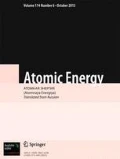The MATS project for research on short-lived nuclides using ion traps is described. The physical program is aimed at performing nuclear-physical and astrophysical research using exotic nuclei which are near their boundaries of nucleonic stability. The project is devoted to precision measurements of the masses (total binding energy) and spectroscopic characteristics of ideally separated nuclides in traps. The development of novel methods will also make it possible to develop the applied components of the project.
Similar content being viewed by others
References
K. Blaum, Yu. N. Novikov, and G. Werth, “Penning traps as a versatile tool for precise experiments in fundamental physics,” Contemporary Phys., 51, 149–175 (2010).
D. Rodriguez, K. Blaum, W. Nortershauser, et al., “MATS and LaSpec: high-precision experiments using ion traps and lasers at FAIR,” Eur. Phys. J. Special Topics, 183, 1–123 (2010).
L. Brown and G. Gabrielse, “Geonium theory: single electrons and ions in a Penning trap,” Rev. Mod. Phys., 58, 233–311 (1986).
S. Eliseev, M. Block, A. Chaudhuri, et al., “Octupolar excitation of ions stored in a Penning trap mass spectrometer – a study performed at SHIPTRAP,” Intern. J. Mass Spectrometry, 262, 45–49 (2007).
M. König, G. Bollen, H.-J. Kluge, et al., “Quadrupole excitation of stored ion motion at the true cyclotron frequency,” Intern. J. Mass Spectrometry Ion Processes, 142, 95–116 (1995).
J. Kettelaer, J. Kramer, D. Beck, et al., “TRIGA-SPEC: a setup for mass spectrometry and laser spectroscopy at the research reactor TRIGA Mainz,” Nucl. Instrum. Meth. A, 594, 162–177 (2008).
D. Dahl, “SIMION for the personal computer in reflection,” Intern. J. Mass Spectrometry, 200, 3–25 (2000).
K. Blaum, G. Bollen, F. Herfurth, et al., “Carbon clusters for absolute mass measurements at ISOLTRAP,” Eur. Phys. J. A, 15, 245–248 (2002).
Author information
Authors and Affiliations
Additional information
Translated from Atomnaya Énergiya, Vol. 112, No. 2, pp. 117–124, February, 2012.
Rights and permissions
About this article
Cite this article
Novikov, Y.N., Vasiliev, A.A., Gusev, Y.I. et al. High-precision method of measuring short-lived nuclides by means of developed systems of ion traps for high-charge ions (MATS project). At Energy 112, 139–146 (2012). https://doi.org/10.1007/s10512-012-9535-4
Received:
Published:
Issue Date:
DOI: https://doi.org/10.1007/s10512-012-9535-4




